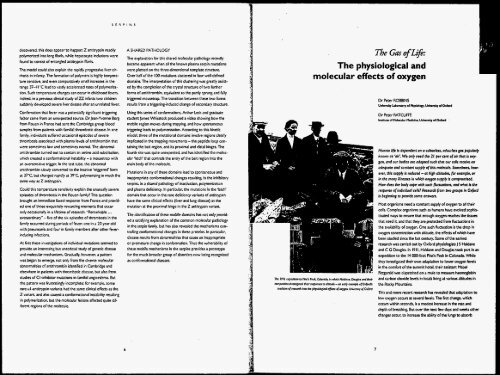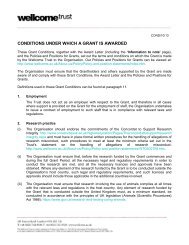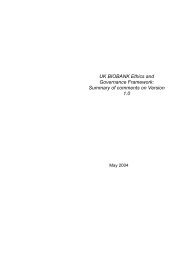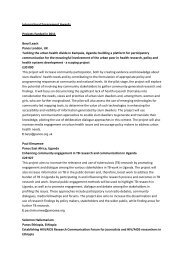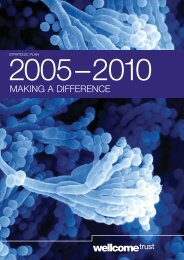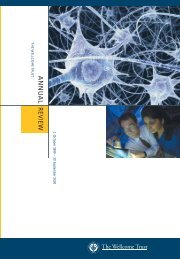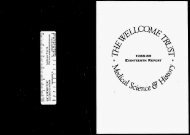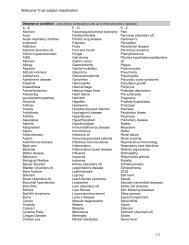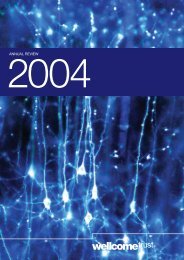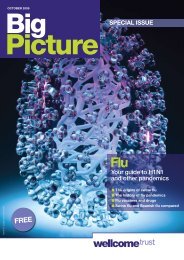The structure and function of serpins
The structure and function of serpins
The structure and function of serpins
You also want an ePaper? Increase the reach of your titles
YUMPU automatically turns print PDFs into web optimized ePapers that Google loves.
discovered this daes appearto happen: Z sntwrin rerdiiy<br />
pobmerized imo bng fibnh. whale hepatmfie indw~ns were<br />
found to conrirl <strong>of</strong> emangkd anutvpYin fibnb<br />
<strong>The</strong> model could also explain the rapidly pmgreirive liver cirrhe~<br />
(n 8nfancy. <strong>The</strong> foimation <strong>of</strong> pipmen ir highlyramperalure<br />
mstne. <strong>and</strong> wen comparatively mall incream in the<br />
range 37-41.C lead to vastly arreleraied rater <strong>of</strong> palymetira.<br />
fion. Such temperature ChMgel an occur in childhood feuen<br />
Indeed. m I pre~"ous tliniral nu* <strong>of</strong>U infant$ two children<br />
suddenly developed severe Iwr direaie ahv an unrelated fever.<br />
Confimiatm that fever was a piiiemially rigmfirant ttiggenng<br />
factor came fmm an unexpected IOYX~. DiJean-Yvvonne Bog<br />
fmm Rouen in Fmce had rem the Cambo$e gmup blood<br />
$amplel from pai,emi wnh familial thmmbdic direaie. In one<br />
family. indmduais ruiiered ~ccasional episodes <strong>of</strong> severe<br />
thromboiis aimciaed with plarma levels <strong>of</strong> amnhmmbin that<br />
were sometimes IOW <strong>and</strong> mnetimei nmal. <strong>The</strong> abnomi<br />
amiihmmbn turned out 10 comain an amino acid iubrtnuGon<br />
wh-th created a coniomtional instability - a ~ uieln~ with<br />
an oveneniilne tngger. In the t a tube. the abnoml<br />
amlhmmim slowly Convened tothe inaLtive ïnpgereS fon<br />
at 37'C but changed rapidly I 39'C polymenting in much the<br />
sme way ai Z anutpmim<br />
At fint these invertigattonr 01 mdividual mutations seemed to<br />
pmvide an imereniog but anecdotal study <strong>of</strong> genetc disea$e<br />
<strong>and</strong> moleiular m-hanirmr. Gradually. however. a pattern<br />
was began lo emege. MI only fmm the dwene moleLulai<br />
abnomaLUîS <strong>of</strong>imnhmmbin identified m Cambndge <strong>and</strong><br />
elsewhere k m patiemr wnhthmmbotic dileale. but ab0 fmm<br />
nudm dCImhbnwmcMt8om (n familsa1 angioedem. But<br />
the patem was fninratinghl inmmplate: forexampk. mmc<br />
rare al-amspmiin vaMnts had the rame ilinkal effects a$ the<br />
Z vanant. <strong>and</strong> all0 omed a caniormatimal innabilny reruHing<br />
in pelpme~tion. bin the molecular lnionr affeded qune di6<br />
rent mgions <strong>of</strong>the motccuic<br />
A SHARED PATHOLOGY<br />
ihe explanation for this shared molemlar pathology recently<br />
became apparent when &II the known piaims repin mutations<br />
were plotted an the 1hree.dimenrionaI lemplate nmum<br />
Over haK <strong>of</strong>the 100 mutationr dunered ~n fou? well-defined<br />
domains <strong>The</strong> interpretation <strong>of</strong>thii clme& WI greatly aisiil.<br />
ed bythe completion <strong>of</strong>the rryslul slmcture <strong>of</strong>two funher<br />
lam3 <strong>of</strong>snthhmmbin. eq~ivdlem 10 the paniy sprung <strong>and</strong> fuiw<br />
lrggered mouretrap. <strong>The</strong> tmnmon between these WO fomr<br />
rerub fmm P ttiggetinpindured change <strong>of</strong> iecondary wcture.<br />
uling this reiw af~onbmationt. Anhw Lerk <strong>and</strong> graduate<br />
nudent Jamer Mi$himotL produced I video showing how the<br />
mobile region mwei dvnng mppiog. <strong>and</strong> how spontaneous<br />
ttipgeting leads to polymercation. Amwding to thil Unetic<br />
model. three <strong>of</strong>the mutaionil domains invobe regions ileidy<br />
impliated in the trapping movements - the peptide loop con-<br />
taining the ban region. <strong>and</strong> its pmximal <strong>and</strong> diml hinges <strong>The</strong><br />
founh me was qune unexpected <strong>and</strong> has identified the m ob<br />
~bil~tch'<br />
that cornroll the entry dthe bait reepioo into the<br />
min body <strong>of</strong>the molecule.<br />
Mut11i~1 h any <strong>of</strong>thare domains lead to rpomaneour <strong>and</strong><br />
imppmpriate miornationai changer resulting, in the inhibitory<br />
iepnr. in a shared pathology <strong>of</strong> inaaivation. pol)m&ation<br />
<strong>and</strong> piarma deficiency. In paniwlar. the mutations in the 'Iatdi<br />
Cod this tsmperature ~ensil~ny explain the unu~uaily severe<br />
episodes <strong>of</strong>thmmborir in the Rwen family! Th6 queRion domain that occur in the rare deficiency ~ tiimi af antnryprin<br />
bm& an imediate faxed respame fmm France <strong>and</strong> pmvid. have the lame clinid dieai [ïier <strong>and</strong> lung areare) .a$ the<br />
ed one <strong>of</strong> thore erquirncly warding mmem that .xur<br />
only o~aiionalbf in a Lfetime <strong>of</strong> mearch. "Remakable ..,<br />
exinodinary"- he <strong>of</strong>the Y>: episodes <strong>of</strong>thmmborii in the<br />
family occumd dunng petio& <strong>of</strong> fee< one in a 20 year old<br />
mth pneumonia <strong>and</strong> four in family memben akei other fever-<br />
,ndvting<br />
mutation H the pmximal hinge in the 2 antnryprh vatianr<br />
<strong>The</strong> ,demification <strong>of</strong>thne mobile domaini has ~t only pmvided<br />
a satisfying explanation afthe common mdecdarpathology<br />
in the repin family but has also revealed the mechanisms (on.<br />
tmiling cdonnaiond changes in these proteins. ~n parnutar,<br />
dscare reruns from abmmal&rthat cause an inappropriate<br />
or pmmture change in ~~nformatloh Thur the wlnerabiïny <strong>of</strong><br />
these mobile mechanisms in the $vins pdder a pmlotype<br />
forthe much bmader group <strong>of</strong>diiodes now being recognized<br />
as ionfomational direaies.<br />
<strong>The</strong> Gas <strong>of</strong> L@:<br />
<strong>The</strong> physiological <strong>and</strong><br />
molecular effects <strong>of</strong> oxygen<br />
...<br />
7


